#Star Trek: Starfleet Command II - Empires at War
Explore tagged Tumblr posts
Text
When I was a kid, my parents bought me Starfleet Command II in a big box from Sam’s Club.
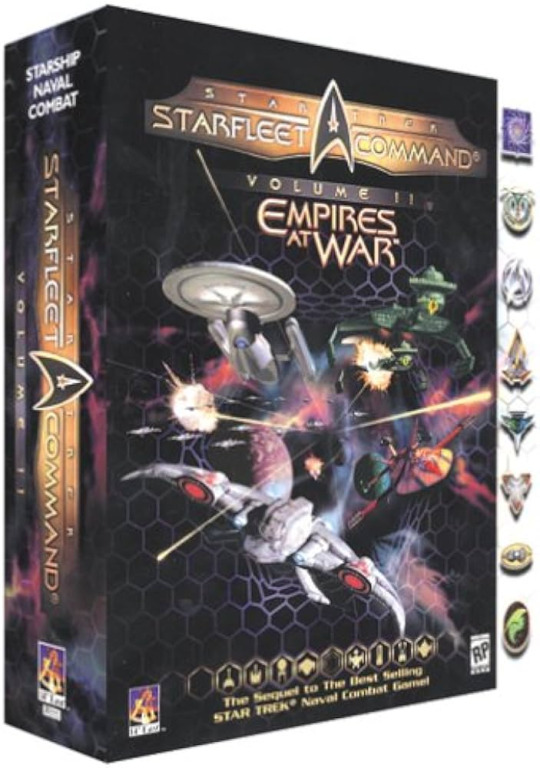
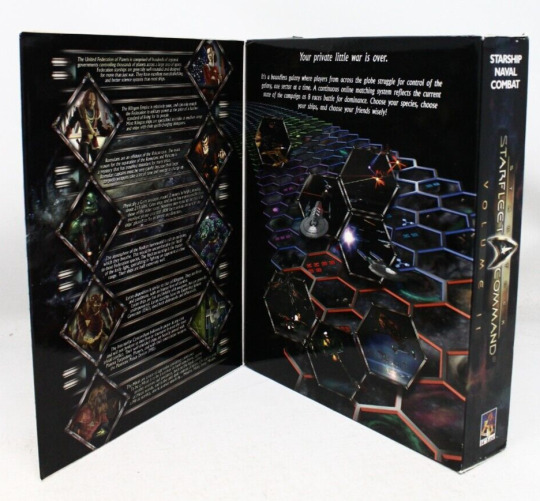
The game had a bad CD key and was unplayable. The dev had just gone defunct, so there was nobody to reach out to for support.
However, that game had a standalone expansion, so we ended up playing that instead.

A game company’s crappy anti-piracy measure drove me to play the pirate game instead.
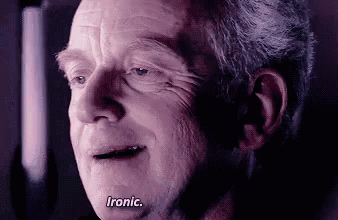
#star trek#star fleet battles#starfleet command#starfleet command ii: empires at war#starfleet command: orion pirates#orion pirates#pc gaming#anti piracy
2 notes
·
View notes
Text
Star Trek: Starfleet Command II: Empires at War
Original Release: 2000
Developer: Taldren
Publisher: Interplay
Platform: PC
Version played: Orion Pirates v2.564
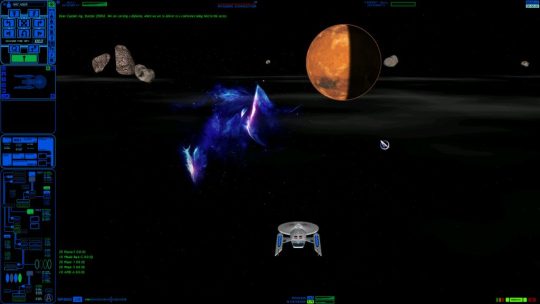
In order to get this to work, I had to play a version of the standalone expansion Orion Pirates, released in 2001. This version has all the content from the base game added, but also some graphical enhancements – but the important thing is that it’s still the original gameplay.
For the most part, it’s the same game as the first. People who know the game extremely well will probably notice various balance changes and additional features, but the game is so in depth that it’s still beyond my understanding. The second game does introduce some new races (including one originally created for the Star Fleet Battles board game) and a new campaign mode.
In the campaign mode, you explore hex tiles until you encounter missions, some are optional while others you must play before moving on. It all looks very impressive, with different hubs for your race and other races, ships moving around and races that are allied with you, but almost all of this is fluff to make it appear interesting and doesn’t impact the game: you just move around and encounter random missions.
For people who like the depth of the combat in this, this version is definitely a really good version to play. You can pick scenarios, modify them or accept the campaign for what it is and have fun with the random missions.
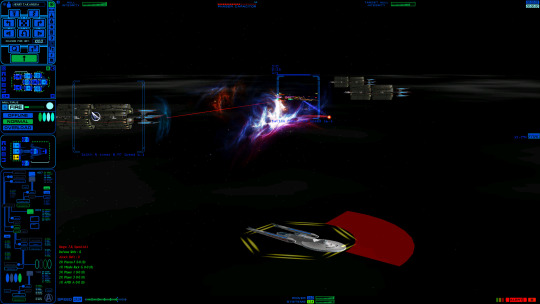

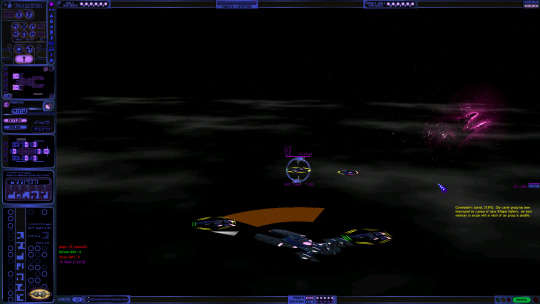
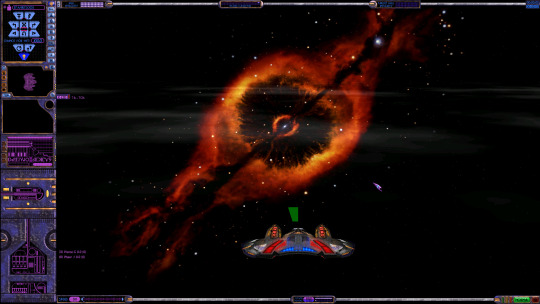
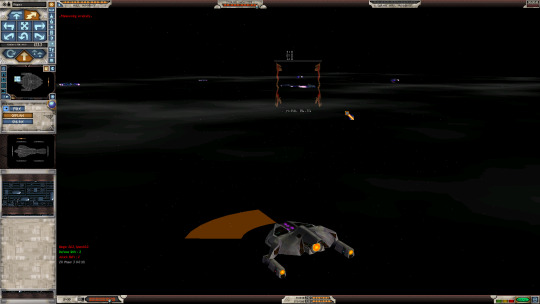
12 notes
·
View notes
Photo
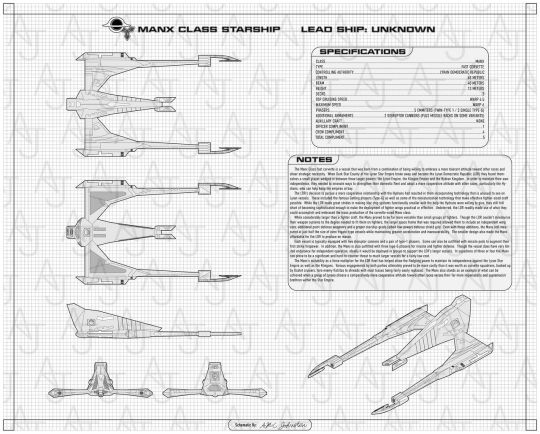
Manx Class Patrol Ship by AJsRealms
#Star Trek#Star Trek: Starfleet Command#Star Trek: Starfleet Command II - Empires at War#Manx Class#Patrol Ship#Lyran Democratic Republic#Sci-Fi#Mecha#Spaceship#AJsRealms
23 notes
·
View notes
Text
DS9 trivia from IMDB - Part 4
- Military ranks used in Star Trek are all based upon actual military ranks. Starfleet ranks are those of the US Navy: Ensign, Lieutenant Junior Grade, Lieutenant, Lieutenant Commander, Commander, Captain, Commodore, Rear Admiral, Vice Admiral, and Admiral. Bajoran ranks are the same as those used in the U.S. Army, Air Force, and Marines: Lieutenant, Major, Lieutenant Colonel (or, as the Bajorans call it, "Field Colonel"), Colonel, and General. (Kira, after her promotion, was referred to simply as "Colonel", but she was promoted two steps in rank at once.) Klingon ranks are "bekk" (an enlisted rating), Ensign, Lieutenant, Commander, Captain, Colonel, Brigadier, General, and Admiral. Cardassian ranks are based on those of the ancient Roman Empire: Gil (equivalent to a Starfleet/U.S. Naval Lieutenant), Glinn (Commander), Gul (Captain), and Legate (Admiral).
- The Maquis was the name of the French resistance fighters during World War II.
- Lit Star Trek model kit parts can be seen as medical instruments throughout the series. In one episode, Dr. Bashir uses a part that makes up a Romulan Warbird engine nacelle to scan or heal.
- As he had on Star Trek: The Next Generation (1987), Q was intended to make semi-regular appearances on this show, but appeared only in season one, episode seven, "Q-Less". Q instead would come to continue his appearances on Star Trek: Voyager (1995). In addition, producers announced Whoopi Goldberg would reprise her role as Guinan in a guest appearance or two, and intended to have Leonard Nimoy appear as Spock, but the plans never materialized. Some other recurring characters from The Next Generation would wind up making appearances on this show, however, including Vash (Jennifer Hetrick), Lwaxana Troi (Majel Barrett), Gowron (Robert O'Reilly), Worf's brother Kurn (Tony Todd) and the Duras Sisters (Barbara March and Gwynyth Walsh).
- The design of Ops incorporates ideas that were considered, but dropped for The Bridge on Star Trek: The Next Generation (1987), such as the upper level office, the briefing table in the center of the room, and the transporter being built into the set.
- Quark and Odo were intended to be the 'Bones and Spock' of Deep Space Nine, the two crew members who were always at odds with each other. However, because Armin Shimerman and Rene Auberjonois spent so many hours together in make-up, they became such good friends that Shimerman felt that their fondness for each other seeped through in the later seasons, despite their best efforts.
- The uniforms initially worn on this show were designed to look different from those worn on its parent show, Star Trek: The Next Generation (1987), with a colored shoulder and a gray undershirt. Beginning with the movie Star Trek: Generations (1994), however, these new uniforms were adopted by Star Trek: The Next Generation (1987) crew, and Starfleet as a whole. This change was made when a new style of uniform designed for Star Trek: Generations (1994) was rejected. From the mid fifth season of this show and Star Trek: First Contact (1996) another type of uniform was issued by Starfleet (now with gray shoulders and colored undershirt), while Star Trek: Voyager (1995) (having no way of knowing about the change) retained the earlier version, distinguishing the two series from each other again. It is also worth mentioning that the DS9-style uniforms are very similar to the ones worn by Starfleet cadets in The Next Generation, most notably in season five, episode nineteen, "The First Duty".
- The square glasses used in Quark's bar are actually candle holders turned upside down.
- The character that eventually became Vic Fontaine was written for Frank Sinatra Jr. in season four. Sinatra, despite being a fan of the show, turned it down, declaring that he only wanted to play an alien. After meeting with Robert Goulet, and attempting to get Steve Lawrence, Tom Jones, and Jerry Vale, the producers eventually considered James Darren for season six, and invited him to audition. However, Darren wasn't interested in a singing role, so he didn't read the script sent to him. On the day of auditions, producer Ira Steven Behr was discussing Darren with a few crew members, sharing his doubts whether Darren would actually show up. One of those crew members happened to be Christian Darren, James' son, who told Behr that his father was actually coming over that afternoon: James' wife had convinced him to at least go to the audition. Darren eventually accepted the role, and appeared in eight episodes.
- Buck Bokai's baseball card, a collectable featured on Benjamin Sisko's desk, had Keone Young on the front, in character, but showed "Trek" model maker Gregory Jein, who invented the "history" of the character, on the back. The pair bore an uncanny resemblance to each other.
69 notes
·
View notes
Text
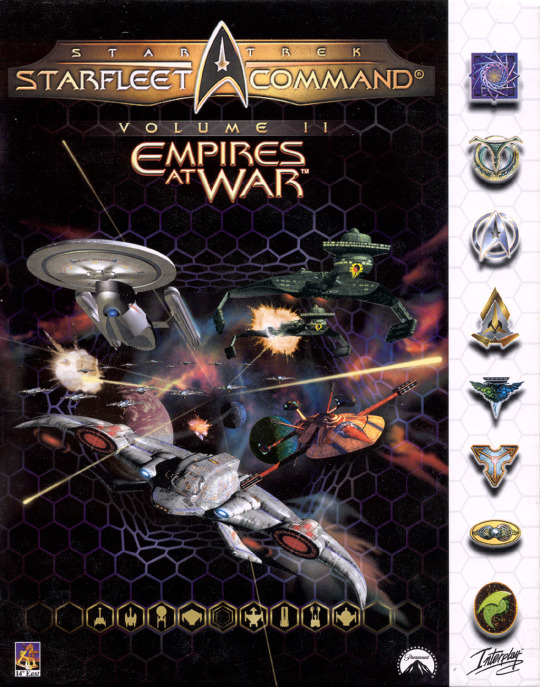
Cover for Star Trek videogame "Starfleet Command Volume II: Empires at War," 2000.
8 notes
·
View notes
Text
Star Trek: Lower Decks Episode 2 Easter Eggs & References
https://ift.tt/eA8V8J
This Star Trek: Lower Decks article contains spoilers for Episode 2.
With its second episode, Star Trek: Lower Decks has shown no sign of slowing down on the endless supply of Easter eggs and deep cuts. Just like with Episode 1, catching everything in an episode of Lower Decks might require you to have the ability to slow down time, just like the Scalosian in the TOS episode, “Wink of an Eye.” But, we don’t have that ability, so we have to rely on our memories and ugly bags of mostly water human bodies which happen to contain the wetware of our brains. In other words, we don’t have Rutherford’s cyber enhancement to help us out.
In Lower Decks episode 2, “Envoys,” Mariner and Boimler go on a hilarious mission together while Rutherford tries to figure out his true purpose in life. Along the way, some of the most famous aliens in all of Trek are referenced, and at least one alien you haven’t thought of in a long time. From a hilarious Wrath of Khan reference to a tour of Klingon cuisine to a very deep cut from one episode of TNG, here are all the Easter eggs and Trekkie references we caught in “Envoys.”
Transdimensional energy creatures
In the very first scene, Mariner and Tendi are accosted by a mouthy orb of pure energy. Mariner is excited about meeting “one of those transdimensional energy creatures,” and when it starts issuing demands, she knows just what to do with it. This kind of “energy ball” alien could reference a similar type of lifeform from the TOS episode “Day of the Dove.” The creature also mentions that it will “feed on fear,” which seems to reference a similar non-corporal lifeform from the TOS episode “Wolf in the Fold.”
Discovery Spore Alien reference
After Mariner shirks the alien down to size, it seems to get itself embedded in the uniform of Captain Freeman. This could reference a small spore alien that was embedded in Tilly’s uniform in Discovery season 1, only to remerge in season 2, pretending to be Tilly’s old junior high friend, May.
“It’s warp time!”
Captain Freeman mentions she wants a cool catchphrase to signal when the Cerritos goes into warp. Obviously, Picard’s catchphrase “Engage,” is the most famous of these kinds of things, even if it was first uttered by Captain Pike in “The Cage.” In Trek 2009 Pike said “Punch It” before going into warp, in a kind of overt Han Solo/Lando Calrissian reference. In Discovery, Pike says “Hit It.”
Castro on the Enterprise
The Lower Decks gang briefly talks about someone named Castro who apparently served on the Enterprise for “like a minute.” Relevantly, at this time, in 2380, Picard is still in command of the Enterprise-E albeit without Riker and Troi. As far as we can tell, “Castro” has never been mentioned or seen in TNG or any of the films before now.
“All Klingon names have an apostrophe for some reason”
This observation about Klingon names is obviously not entirely true. In fact, most of the early Klingons — Kor, Koloth, Kang or even Worf — do not have apostrophes in their names. The preponderance of apostrophes in Klingon names likely begins with the TNG episode “Heart of Glory,” in which we learn there is K’Tinga class Klingon ship, and met a Klingon named K’Nera.
Getting married in a dress uniform
Mariner gives Boimler grief about the fact that he’s wearing a more formal dress uniform by saying, “Nice dress uniform. You getting married after this.” In TNG and Voyager, a dress uniform often appeared in wedding episodes, notably in “Data’s Day.” The dress uniform in Lower Decks is seeming incongruous with the mostly white dress uniforms worn by the Enterprise crew in Nemesis, just a year prior in 2379. That said, the uniforms of the Cerritos already represent a throwback vibe to the TNG uniforms than anything seen in the TNG films.
Blast shield
The shuttlecraft Yosemite has a blast shield. We know it goes up and it goes down. We don’t really know what it does. However, like the sand joke in episode 1, this might be another moment where Lower Decks is throwing in a Star Wars reference. The phrase “Blast shield” is used to describe the part of Luke Skywalker’s helmet that obscures his vision in A New Hope.
Mariner is dreaming about Khan
While Mariner is napping on the shuttle, we catch her murmuring “Buried alive, marooned for eternity.” When she wakes up she says, “I keep having this awesome dream!” She is dreaming about Khan’s famous speech in The Wrath of Khan when he tells Kirk, “I shall leave you as you left me..marooned for all eternity at the center of a dead planet…buried alive…buried alive!” This speech, naturally, is followed by Kirk bellowing “KHAAAAN!!!”
Blood wine, Gagh and Raktajino
This episode makes quick references to Bloodwine (which Mariner and the Klingon envoy drink), Gagh (when Mariner says “the man wants hot worms!”) and Klingon coffee, better known as Raktajino. Gagh originates in the TNG episode “A Matter of Honor,” in which Riker has to eat the still-live serpent worms to prove he’s a badass. Bloodwine also originates in “A Matter of Honor,” though throughout the entire franchise it’s still never been made clear if there is actual blood in the Bloodwine. The most recent reference to Bloodwine was in Discovery Season 2 when Jet Reno referred to the Klingons as “The guys who drink Bloodwine.” Raktajino, meanwhile, originates on DS9, starting with the episode “Dax.”
“Little Qo’nos”
When translated into English, one of the signs (written in Klingon) actually reads “Little Qo’nos,” which makes sense since Mariner called this area of the planet “the Klingon district.” Qo’nos is the homeworld of the Klingon Empire, though the name wasn’t actually revealed until Star Trek VI: The Undiscovered Country. It is sometimes spelled “Kronos.”
Court Martialed
Boimler worries that he and Mariner will be court-martialed for losing track of the shuttlecraft, to which Mariner replies, “don’t knock it until you’ve tried it.” The formal process of court-martial does not necessarily mean one will get kicked out of Starfleet. Both Kirk and Spock were court-martialed in TOS, in the episodes “Court Martial,” and “The Menagerie,” respectively. Apparently, Mariner has been court-martialed, too. This gives her something else in common with TNG favorite, Ensign Ro.
The Khitomer Accords
Boimler is also worried that he and Mariner are “violating the Kitohmer Accords.” This references the general peace treaties between the Federation and the Klingon Empire. These peace talks began in Star Trek VI: The Undiscovered Country, roughly in the year 2293. However, because the Enterprise-C was destroyed near Khitomer in 2344, there seems to have been more than one incarnation of the Khitomer Accords.
Section 31 power walk
Boimler mentions Section 31 as he performs his absurd energy-conserving speed- walk. Because Boimler is only an Ensign, this makes it seem like Section 31 is common knowledge in 2380. In the DS9 era (mostly 2370s) Section, 31 was still top-secret.
Klingon food cart owner has a Mek’Leth
When Mariner and Boimler ask the Klingon who runs a food kiosk about the location of the general, she pulls a Mek’Leth on them. This small, curved Klingon blade was introduced as Worf’s second weapon of choice in the DS9 episode “The Way of the Warrior.” That said, it is most remembered for Worf using it on Borg in zero gravity in the film First Contact.
Kaelon II aliens from TNG’s “Half a Life”
If the distinctive blue and black jumpsuits, combined with veiny foreheads seemed vaguely familiar, that’s because these aliens were seen in exactly one episode of TNG. Mariner mentions that the stares from these aliens make it seem like they’ve never seen a Starfleet uniform. Boimler responds, “Well, they are Kaelons and Kaelons are notoriously isolationist.” In the TNG episode “Half a Life,” we learn that part of the reason why the Kaelons are so closed off from the rest of the galaxy is that they force people over 50 to commit ritual suicide. In “Half a Life,” Lwaxana Troi falls in love with a Kaelon man, only to realize that he’ll be dead very soon.
Retro Klingon disruptors
In a glass case in the Klingon marketplace, there are several old school Klingon disruptors, seemingly for sale. These are straight from TOS, specifically the kind seen in “Errand of Mercy.”
“Warm hot joystick in your hand”
Commander Ransom mentions a “warm hot joystick,” in reference to being on the bridge. This seems like he’s talking about the “manual steering column,” which Riker used to fly the Enterprise in Star Trek: Insurrection. Relative to Lower Decks, that tech is probably fairly new.
Janeway protocol
When Ransom mentions using the “Janeway protocol,” he acts like Rutherford should know what he’s talking about. In truth, we have no idea what the Janeway protocol is other than it references Captain Janeway from Star Trek: Voyager. However, because this holodeck simulation involved temporal rift, it seems possible Ransom is suggesting Rutherford should have tried to use time travel to reset everything. (Janeway does this in both “Year of Hell” and “Endgame.”) That said, Ransom shouldn’t know Janeway used time travel to reset everything, so maybe that’s not it. Chronologically, at this point, Janeway is an Admiral at Starfleet. Or, at least she was the year prior, in Star Trek: Nemesis.
Risa references
One district Mariner and Boimler find themselves in seems to be a knock-off the planet Risa. There’s a giant statue of a horga’hn, and when Boimler is flirted-with, the term “jamaharon” is mentioned. All of this originates in the TNG episode “Captain’s Holiday.” In that episode, Picard vacations on Risa and learns that displaying a statue of a horga’hn means you seek “jamaharon,” which basically just means you want sex.
“I am for you”
The alien woman who tries to plant her eggs in Boimler also seems to read his thoughts and essentially, become what he needs in order to lure him to his doom. This could reference the TOS episode “That Which Survives,” in which Losira (Lee Meriweather) says “I am for you, James T. Kirk” before she kills whoever’s name she has just said.
“In the name of the Prophets!”
Lt. Shaxs is a Bajoran, so when he says “In the name of the Prophets!” it seems to indicate he’s a religious Bajoran. Lower Decks takes place after the finale of DS9, so it seems possible that Bajorians in Starfeelt are even more devout, specifically because their Messiah — Ben Sisko — not only helped end the Dominion War, but also, went to live with the literal Prophets.
A Simulation to learn about defeat
Shaxs tells Rutherford that the “Shmorgishborg” simulation was designed to be unwinnable and to teach people about defeat. This references the idea of The Kobayashi Maru—”the No Win Scenario”—in The Wrath of Khan.
“Shmorgishborg”
The joke “Shmorgishborg” is a play on the word “smorgasbord,” which usually refers to a fancy buffet. The word derives from the Swedish word “smörgåsbord.” In First Contact, when Picard first tells 21st-century resident Lily about the Borg, she replies, “Sounds Swedish.”
Founding members of the Federation
Mariner tries to give Boimler some advice about Andorians, and he replies, “Andorians were a founding member of the Federation, you want to tell me about Tellarties too!” This references the idea that Anodrians and Tellarites are some of the earliest of Trek’s alien species. Both races were first introduced in “Journey To Babel,” and later in the Enterprise episode “United,” the 22nd-century origins of the Human-Tellarite-Anodrian alliances are made clear.
Vendorian shapeshifter
Without a doubt, the deepest cut in the episode. Boimler and Mariner briefly encounter a tentacled Vendorian, a shapeshifting alien that was first seen in a 1973 episode of The Animated Series called “The Survivor.” In that episode, the Vendorian ended-up being helpful and saving the crew. In this case, not so much.
Ferengi throwback
Although the Ferengi who confronts Boimler and Mariner is eventually revealed to be a pretty nice guy, the overt reference here is to the over-the-top way the Ferengi behaved in their very first appearance in the TNG episode “The Last Outpost.” From the fur outfit to the “hand thing,” this Ferengi is designed to evoke our 1987 memory of how absurd these guys first looked. When Mariner says she thinks he’s a Bolian, it’s an obvious tip to the audience that she’s lying. Boilans are the blue-skinned folks who, are perhaps best represented by Mr. Mot, the barber on the Enterprise-D in TNG.
But. In terms of this portrayal of the Ferengi. Go back to “The Last Outpost,” and look for the “hand thing.” The recreation here is spot-on.
The post Star Trek: Lower Decks Episode 2 Easter Eggs & References appeared first on Den of Geek.
from Den of Geek https://ift.tt/3kALBcd
1 note
·
View note
Text
TNG: “Unification II”
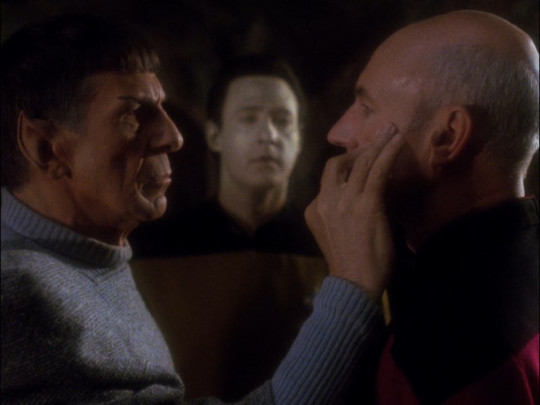
Captain Picard and Lt. Commander Data learn that Ambassador Spock came to Romulus to guage the potential for a Vulcan-Romulan reunification. Meanwhile, the Enterprise pursues its leads on the materiel stolen from Qualor II. When Spock deduces a connection between these matters, he uncovers a Romulan plot. Commander Sela captures Spock, Picard, and Data before stepping up the timetable for a Romulan invasion of Vulcan.
Since the Cold War greatly influenced Star Trek’s approach to depicting the Federation’s relationship with rival powers, the end of the Cold War had a massive impact on the franchise’s 25th anniversary events. Star Trek VI depicted the Klingons being unable to afford continued hostilities with the Federation, forcing old soldiers to confront the sudden end of a seemingly eternal conflict that had defined their lives. This episode, on the other hand, alludes to uprisings in Eastern Europe in 1989, and the reunification of NATO’s West Germany and the Warsaw Pact’s East Germany a year later.
The German reunification metaphor is a bit shaky, though, since Vulcan is a founding member of the Federation and Romulus is the seat of power for its own empire. Spock doesn’t address whether the policy he’s pursuing would have Vulcan exit the Federation to cogovern the Romulan Star Empire, or if Romulus would abandon its imperial possessions to become a Federation member. For all I know we’re supposed to think Vulcan-Romulan reunification is effectively synonymous with the a union between the whole Federation and the entire Romulan state. The questions of sovereignty make this far more complicated than, for example, a bilateral non-aggression treaty, which makes it pretty illogical for Spock to seriously believe Proconsul Neral would greenlight it this afternoon.
Since I previously mentioned my confusion about the “missing Vulcan ship” angle, let’s go over how it fits into the Romulans’ plan. The Romulans want to send 2,000 troops to Vulcan, posing as a peace envoy. To that end they try to convince Spock to endorse a peace initiative, and they need to steal three Vulcan transport ships. One of those ships, the T’Pau, is procured from the smuggling ring at Qualor II. But the Romulans don’t get the T’Pau’s navigational deflector, which was apparently fenced off to a completely different party, and went down with a Ferengi cargo ship. I find it odd that the Romulans would leave that loose end for Starfleet to find, especially since the T’Pau is pretty useless without a deflector.
For that matter, I find it strange that the Romulans expect to send three Vulcan ships across the Neutral Zone without raising a lot of red flags. The Vulcans may not know what Spock is up to, but they sure know they didn’t give him three ships to do it. Even if Spock pulled some “cowboy diplomacy” and “borrowed” the ships, he’d have no motive to make them unidentifiable upon their return. So a lot of this plan really hinges on Sela’s remark that she just needs to keep everybody confused until the invasion force lands on Vulcan. In effect, the excuse for every plot hole here is that the Romulans are very, very sloppy. Then again, that would also account for how quickly Spock and Data hack their intelligence network and effortlessly pwn them at every turn.
This episode is the final appearance of Spock until the 2009 film Star Trek, in which he disappears into the alternate timeline of that movie and its sequels. (His death is reported in 2016’s Star Trek Beyond.) His last official act in this timeline, then, was a 2387 attempt to prevent the Romulan sun from exploding. I always liked that detail, because it played into his dedication to the Romulans as established here. And now, thanks to Star Trek: Picard, we know Spock wasn’t the only good dude from this episode looking out for the Romulans in that crisis, which also seems fitting.
4 notes
·
View notes
Text
Star Trek Voyager: The Killing Game, Part II

Episode 4.19 “The Killing Game, Part II” Stardate 51715.2
Janeway and Seven know who they are and they are both in their “Maquis” black, on Voyager, looking for help to deactivate the neural interfaces.
Meanwhile, Chakotay, Tuvok, Tom and B’Elanna still believe they are their characters in the simulation, believing they are trying to destroy Nazi headquarters. Chakotay immediately takes command. Tom and B’Elanna have their usual banter, even as their holodeck characters. It begs the question of whether the Hirogen knew about Tom and B’Elanna’s relationship when they created and assigned the characters, or if there was some other way that they adopted those characters and relationships. Same thing is true with Janeway and Chakotay. Janeway and Seven make it back to the holodeck, and Janeway convinces everyone to go along with her plan to destroy the “Nazi compound.” She insists on going alone to destroy it; Chakotay insists on going with her.
Harry runs into Tom, and even though Tom doesn’t recognize him, they have their usual friendship.
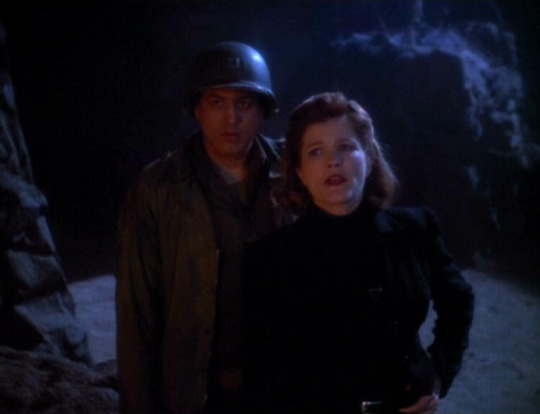
Chakotay tells Janeway she’s a “gung-ho kind of gal,” and that he’s not used to that. He tells her not a day goes by that he doesn’t want to get his men home, even if he dies trying. She recognizes the irony and says she knows the feeling. Even when Chakotay is not himself, he and Kathryn trust each other. Neelix is in the Klingon simulation, and Janeway takes Chakotay there to recruit the Klingons to their cause. The Klingon Neelix insists that they prove their fortitude by drinking. Chakotay offers his hand to Kathryn to help her down from the rock. Janeway calls the Doctor to the holodeck to get him in on the plan. Chakotay builds an explosive which they set under sickbay, and Janeway and Chakotay break into sickbay together. Janeway manages to disable the forcefield but is shot in the leg. Everyone remembers who they are.
Tuvok, Seven, B’Elanna and Tom are taken prisoner by the Hirogen. Tom, the Earth history aficionado, is the only one who knows about the Nazis and World War II. The holographic Nazi who was with B’Elanna slaps her, and Tom tries to protect her.
The Hirogen leader tells Janeway that they need to repair Voyager. He explains to her that he’s trying to build a future for his people, that the holodeck technology would offer a new way of life. Janeway, still wounded, talks with him. The Hirogen leader tells Janeway that humans recognize the need for change. He tells her he admires their cunning. Janeway says if he gives her her ship back, she’ll call a cease fire and give the Hirogen the holodeck technology. The Hirogen leader agrees.
Back on the holodeck, the Hirogen second-in-command is becoming dissatisfied with his orders not to kill his prey. He orders Seven to sing. She declines. Tuvok tells her that it would be logical to do what he asks since he is holding a gun to her. Seven replies that logic is irrelevant and tells the Hirogen that one day his species will be assimilated by the Borg. At that moment, the Hirogen leader calls the holodeck and tells them about the cease fire. However, the holographic Nazi convinces the Hirogen second-in-command that they need to continue to fight.
The Doc is monitoring the simulations. He tells Neelix he has to convince the Klingons to fight with the Nazis. “They’re Klingons, not kittens,” the Doc reminds Neelix. Janeway is in engineering with the Hirogen leader. She tells Harry they have to overload the holoemitter network to shut down the holodeck simulations. The second in command enters engineering and kills his superior. He tells Janeway she is now his prey and orders her to run. She, still wounded in the leg, has no choice but to do as he asks.
Back on the holodeck, Chakotay checks in with his troops who are being badly beaten by the Nazis.
Harry initiates the holo-emitter overload.
Seven creates a device that will disrupt holographic activity, but she is shot before she can throw it at the Nazis. Chakotay is forced to surrender.
Janeway feigns weakness to lure her Hirogen hunter into a trap. Then he becomes the hunted. Chakotay and the others are lined up for a firing squad when the Klingons enter the battle and give Chakotay the advantage. Janeway tells the Hirogen to tell his hunters to stand down; he refuses and she kills him. The holoemitters overload and all the characters disappear.
In her log, Janeway says that there have been heavy casualties on both sides and that Voyager has taken heavy damage. They finally negotiate a cease fire. Janeway gives the holodeck technology to the Hirogen as she had promised their leader she would.
Original Airdate: March 4, 1998
Production Number: 187
Episode Tags: P/T, J/C
Meanwhile, back in the Alpha Quadrant...
Sisko posts the list of Starfleet casualties in every week on Friday. He has been posting the list for the last 3 months. The Romulans have a non-aggression pact with the Dominion. Sisko decides he wants to bring the Romulans into the war. Sisko is convinced that the Romulans are going to want proof that the Dominion is not a trustworthy ally. Sisko asks Garak to find this proof on Cardassia. Garak warns Sisko that it's going to be messy. Sisko replies he's prepared to do whatever it takes to bring the Romulans into the war. Garak agrees. The Dominion invades Betazed. Garak tells Sisko that all of his former colleagues on Cardassia were killed within a day of speaking with him. Garak convinces Sisko that they should manufacture the evidence themselves. Sisko meets with a Romulan. Dominion shipyards are operating at full capacity while the Federation is still rebuilding theirs. The Romulan senator realizes that the data is a fake. The Romulan senator who Sisko spoke with is killed on his way home by the Dominion. Sisko realizes that this was Garak's plan all along. The Romulan Empire declares war against the Dominion and strike 15 posts immediately. Only Sisko and Garak know the full story.
#star trek#star trek voyager#voyager#janeway#captain janeway#kathryn janeway#chakotay#j/c#p/t#paris x torres#janeway x chakotay#episode#episode guide#summary#kj115's episode guides
5 notes
·
View notes
Text
Actors who appeared in both Star Trek and Star Wars – VIII of X
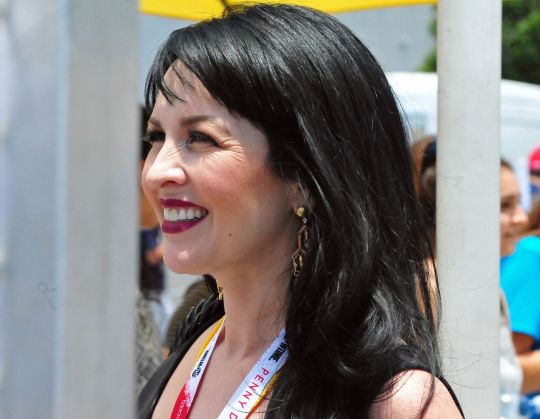
Status Post #8678: Grey Griffin
Star Trek – Various voice roles (represented by female characters in TOS) in Star Trek: Starfleet Command II - Empires at War (2000)

Media: Star Trek: Starfleet Command II - Empires at War (2000)
youtube
Star Wars – Naare in The Freemaker Chronicles (2016)

Media: Lego Star Wars: The Freemaker Chronicles (2016)
youtube
0 notes
Photo

Star Trek: Starfleet Command Volume II - Empires at War
3 notes
·
View notes
Text
How Star Trek: The Next Generation’s Killing of Tasha Yar Became an Awkward Mistake
https://ift.tt/32BBsEk
“[I] died a senseless death in the other timeline. I didn’t like the sound of that, Captain. I’ve always known the risks that come with a Starfleet uniform. If I am to die in one, I’d like my death to count for something.”
Denise Crosby’s Lt. Tasha Yar, Star Trek: The Next Generation’s inaugural chief of security, managed—due to some alternate timeline trickery—to take that legendary meta-minded dig at her own death from two years earlier in the Season 1 episode, “Skin of Evil.” With that episode having originally aired on April 25, 1988, the anniversary is a good occasion to look back on the controversial behind-the-scenes circumstances that resulted in poor Tasha’s unspectacular, abrupt, red-shirt-like fatal encounter with an alien tar monster on a cheap-looking set.
“Skin of Evil” was the 22nd episode of Star Trek: The Next Generation’s inauspicious inaugural season—just three episodes away from the season finale. Consequently, with audiences at this point having stuck with the show for seven months since its September 26 premiere, the death of a main cast member certainly felt like a stakes-redefining kick against procedural complacency. However, those who had been following industry trades, and read the then-fresh, spoiler-teasing cover story exposé in Starlog magazine, titled “The Security Chief Who Got Away,” pretty much already knew that Crosby was on the outs with the series. Thus, the prevalent question going into Season 1’s final few episodes was not if Tasha Yar was leaving the Enterprise D, but how. Well, said how would prove to be one of the most controversial, lamentable moments in Star Trek history.
While Crosby denied the growing rumors of her impending exit during contemporaneous interviews published before “Skin of Evil” aired, she had indeed quit the series, mostly due to the lack of character development given to Tasha Yar. While she was given a backstory of a rough upbringing on the lawless abandoned Earth colony, Turkana IV, Yar’s only real moment in the spotlight (besides her famous seduction of android Data in “The Naked Now” while under alien viral influence,) had been Episode 3, “Code of Honor,” in which she became the amorous focus of an authoritarian alien leader, and would be forced to participate in a campy fight to the death with the leader’s outraged first wife. Thus, dealing with the show’s notoriously demanding schedule, and faced with the believed prospect of spending years soullessly saying “hailing frequencies open,” Crosby put in a request to be released from her contract, which creator Gene Roddenberry granted.
Unfortunately for Tasha Yar, Roddenberry’s acquiescence would come with a shocking caveat: a sudden and underwhelming onscreen death. “Skin of Evil,” directed by Joseph Scanlan, written by Joseph Stefano and Hannah Louise Shearer, set things up with a rescue mission after an Enterprise shuttlecraft containing Counselor Deanna Troi and pilot Lt. Ben Prieto crashed on the barren planet, Vagra II. Accordingly, Yar joins an away team consisting of Cmdr. William Riker, Lt. Cmdr. Data, Dr. Beverly Crusher to the planet surface, on which they encounter a powerful, tar-like creature that calls itself Armus. There, Yar quickly loses patience as the creature continues to block their rescue effort, and tries to move past it, resulting in an attack that sends her flying backwards, leaving her tar-marked face lifeless on the ground as the essence drains from her body; a condition even beyond the help of subsequent emergency efforts back on the Enterprise. Thus, Yar’s arc, for what it was, had come to an anti-climactic conclusion; a fate attributed to the dangerous nature of Starfleet service, especially for someone in security. However, said fate allegedly wasn’t inspired by any artful motivations.
Read more
TV
Why Star Trek Needs More Characters Like Captain Lorca
By Lacy Baugher
TV
Q’s Return on Star Trek: Picard Season 2 will Follow “Significant Trauma”
By Joseph Baxter
So, why did Yar’s exit down this way? Crosby recounted in 1993 behind-the-scenes book, Trek: The Next Generation Crew Book that “Gene [Roddenberry] really felt that the strongest way to go would be to have me killed. That would be so shocking and dramatic that he wanted to go with that.” However, another anecdote-touting tome, 1992’s Trek: The Unauthorized Behind-The-Scenes Story of The Next Generation, alleges that the “Skin of Evil” script—as with other Season 1 episodes—was secretly tweaked and/or rewritten by Roddenberry’s lawyer, Leonard Maizlish, who held an ambiguously-defined full-time staff position on the series. The purported rewrite, which would have been illegal in the Writer’s Guild, was believed to have been designed to deny any dramatic or sentimental value to Crosby’s character. With Roddenberry having recently lost creative control of the Star Trek movie franchise from Paramount Pictures, Maizlish may have been there to protect his bottom line, in this case ensuring that a dead-and-forgotten Tasha would leave no incentive for a potentially-costly new contract for Crosby down the line.
Nevertheless, “Skin of Evil” concluded with an emotional sendoff for Yar, with a memorial service—consisting of only the main cast member characters—set on the holodeck, where the late security chief posthumously delivers well wishes to her colleagues, notably a weeping, possibly guilt-ridden rescuee, Troi (actress Marina Sirtis was reacting to Crosby’s set presence off-camera). Yet, Crosby still had to endure the show’s apparent power plays, even after said memorial, since the show’s out-of-sequence production schedule resulted in her having to shoot one last appearance for her death episode’s immediate predecessor, Episode 21, “Symbiosis,” which also provided another famous Tasha Yar moment, in which she delivers a ham-fisted, Just-Say-No-era anti-drug speech to Wesley Crusher when addressing the episode’s alien drug pushers. It’s a bit of trivia that Crosby famously used in 2019 in a now-famous Twitter dunk on controversial executive producer Rick Berman.
Oh friend, my final scene on @StarTrek was not in SKIN OF EVIL but SYMBIOSIS which was filmed out of order. You came to the set to thank me and brought a cake, then ceremoniously ripped off my Communicator badge saying “you won’t be needing this anymore.” Don’t remember?
— Denise Crosby (@TheDeniseCrosby) February 4, 2019
While Crosby’s post-Star Trek aspirations wouldn’t quite pan out the way she had likely envisioned, save for a co-starring role in 1989 movie Pet Sematary, (she’s recently banked an impressive amount of TV appearances, notably on shows like The Walking Dead and Ray Donovan,) her apparent status as persona non grata on the Enterprise wouldn’t last long, and she would make a monumental return as Tasha in 1990 Season 3 episode “Yesterday’s Enterprise,” in which a temporal anomaly alters the timeline of the Enterprise D, creating a reality in which the Enterprise D is fighting a war with the Klingon Empire, and an anachronistic Season 3-era Yar is very much alive. Pertinent to the episode’s time-bending meeting with predecessor vessel the Enterprise C, Yar—after learning of her main timeline death from Guinan—would transfer to the embattled historical ship (after the earlier-quoted speech,) to ensure that it fulfills a sacrificial destiny to prevent a war that wasn’t supposed to take place, finally giving meaning to her death.
“Yesterday’s Enterprise” was so well-received that it facilitated more Yar-adjacent material, first with the 1990 Season 4 episode, “Legacy,” in which the Enterprise crew go to Tasha’s home, Turkana IV, and become embroiled in a scheme concocted by her bitter estranged sister, Ishara (Beth Toussaint). However, a prominent Crosby comeback would dominate Seasons 4-5’s two-part cliffhanger storyline, “Redemption,” when she played Commander Sela, the daughter of the “Yesterday’s Enterprise” alt-timeline Tasha Yar and a Romulan general to whom she was forced to become a concubine after the Enterprise C’s war-preventing act. In a twist of fate, Crosby, once an underutilized outcast crew member, had been positioned to play one the show’s most memorable villains, since Sela is a ruthless, unwaveringly loyal servant of the bellicose Romulan Empire, and displays her own heartlessness when revealing that her mother, alt-Tasha, was killed while trying to escape with her as a child. Additionally, Crosby reprised the role of prime-Tasha in Picard’s Q-conjured pilot-era flashbacks of 1994 two-part series finale “All Good Things.”
Paramount Television
cnx.cmd.push(function() { cnx({ playerId: "106e33c0-3911-473c-b599-b1426db57530", }).render("0270c398a82f44f49c23c16122516796"); });
Historically, it seems clear that a series of myopic mistakes rendered Denise Crosby’s Star Trek journey more circuitous than necessary. However, the result was a character arc that stands the test of time. Plus, not for nothing, the fantastical nature of current spinoff series Star Trek: Picard could easily facilitate a contemporary Crosby comeback—either as Commander Sela (who eventually became a Romulan empress in the non-canon story of video game Star Trek Online,) or even as alt-Tasha, whose alleged death was never confirmed onscreen. To put it in the parlance of the late security chief, such a comeback would be a jewel for fans.
The post How Star Trek: The Next Generation’s Killing of Tasha Yar Became an Awkward Mistake appeared first on Den of Geek.
from Den of Geek https://ift.tt/2Pbbdl5
1 note
·
View note